Have you ever lost yourself in the thicket of unique visitors, new users, pageviews, and sessions in Google Analytics?
In this article, we’re going to discuss what these numbers actually mean and how you can analyze them to make better decisions about your marketing campaigns. To make it more cozy, let’s meet at a cafe…
Key takeaways
- In Google Analytics 4, visitors are called users, and visits are called sessions.
- GA4 groups distinct users in four different buckets. As a result, you can see 4 types of unique visitors in GA4.
- GA4 uses four methods to track users and identify them as unique visitors.
- You can change the way GA4 tracks visitors, but it’s risky.
- GA4 cannot identify all your visitors, but that’s fine.
- Visitor and user metrics are helpful to analyze your audience and improve your marketing strategy.
Video: unique visitors in Google Analytics 4
If you'd prefer to watch instead of read, here's a video explaining all the ways that GA4 uses to identify unique visitors:
What is a visitor in Google Analytics, anyway?
First, let’s clarify exactly what a unique visitor is in Google Analytics: Unique visitors, or new users, describe the number of unduplicated visitors to your website over the course of a specific time period.
When you open Google Analytics, the first metrics you will notice are “Users” and “Sessions.”
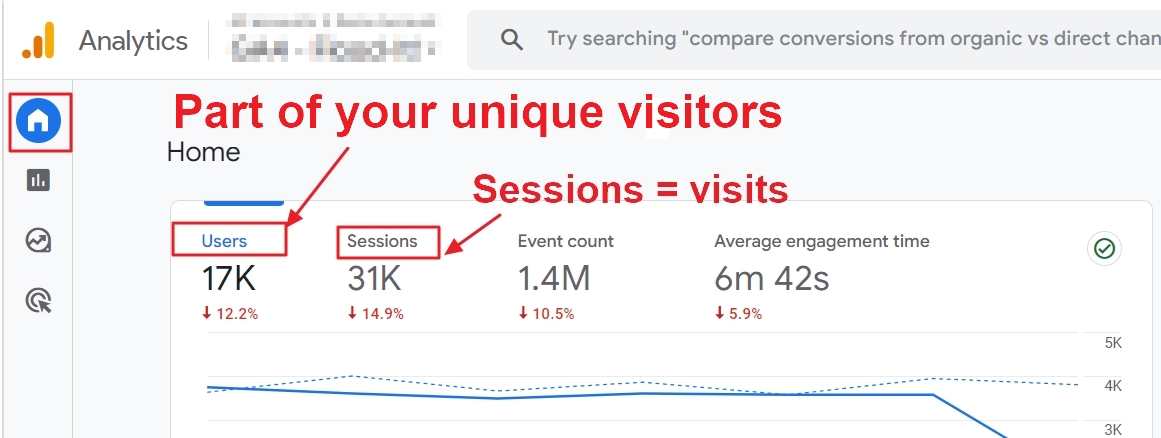
The terminology might be a bit confusing if you are just starting with Google Analytics. But that can also be the case for seasoned GA users.
Before 2014, Google used different terminology:
- Visitors are called Users in GA4.
- Visits are called Sessions in GA4.
To simplify things and understand unique visitors (users) and visits (sessions), let’s assume four people – Ben, Eva, Matt, and Cindy visit a cafe for lunch.

In this example, visiting a cafe corresponds to visiting your website. Later in the evening, Ben and Eva drop into that cafe again for coffee.
Assuming that there are no other visitors, the unique number of visitors to the cafe on that particular day is four.
Google simply calls these “users” in most reports, such as the real time report where you can see how many visitors are currently on your site.
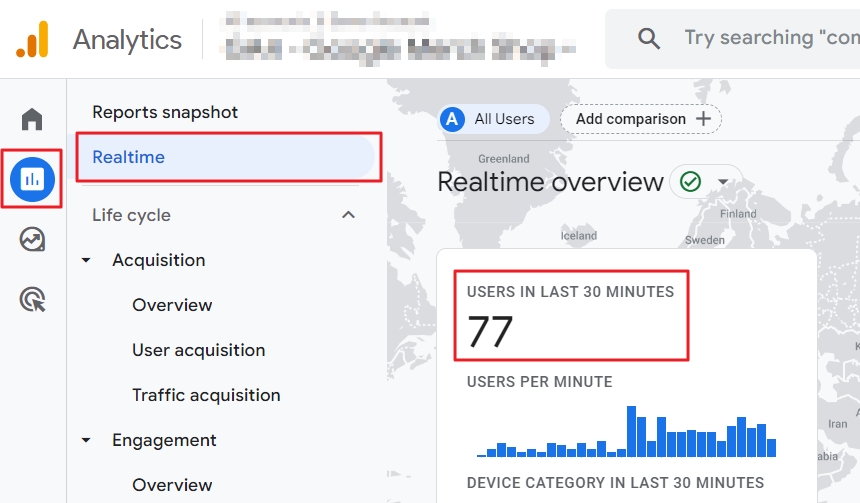
Back to the cafe. The total number of visits is six, and Google usually refers to these as sessions.
So, what is a unique visitor in Google Analytics4?
GA4 automatically segments every visitor of your site into 4 user groups that can overlap each other. Total Users, Active Users, Returning Users and New users are all unique visitors in their own way.
But of course, they are different from each other.
- All Users: Every unique visitor, whether they do or don’t do anything on your site (or app).
- (Active) Users: Only the group of engaged unique visitors OR anybody who visits the site for the first time
- New Users: A visitor who enters your site for the first time.
- Returning Users: Anybody who re-visits the site and who can be active or not.
This simple scheme shows what criteria GA4 uses to assign a visitor to one of the above groups.
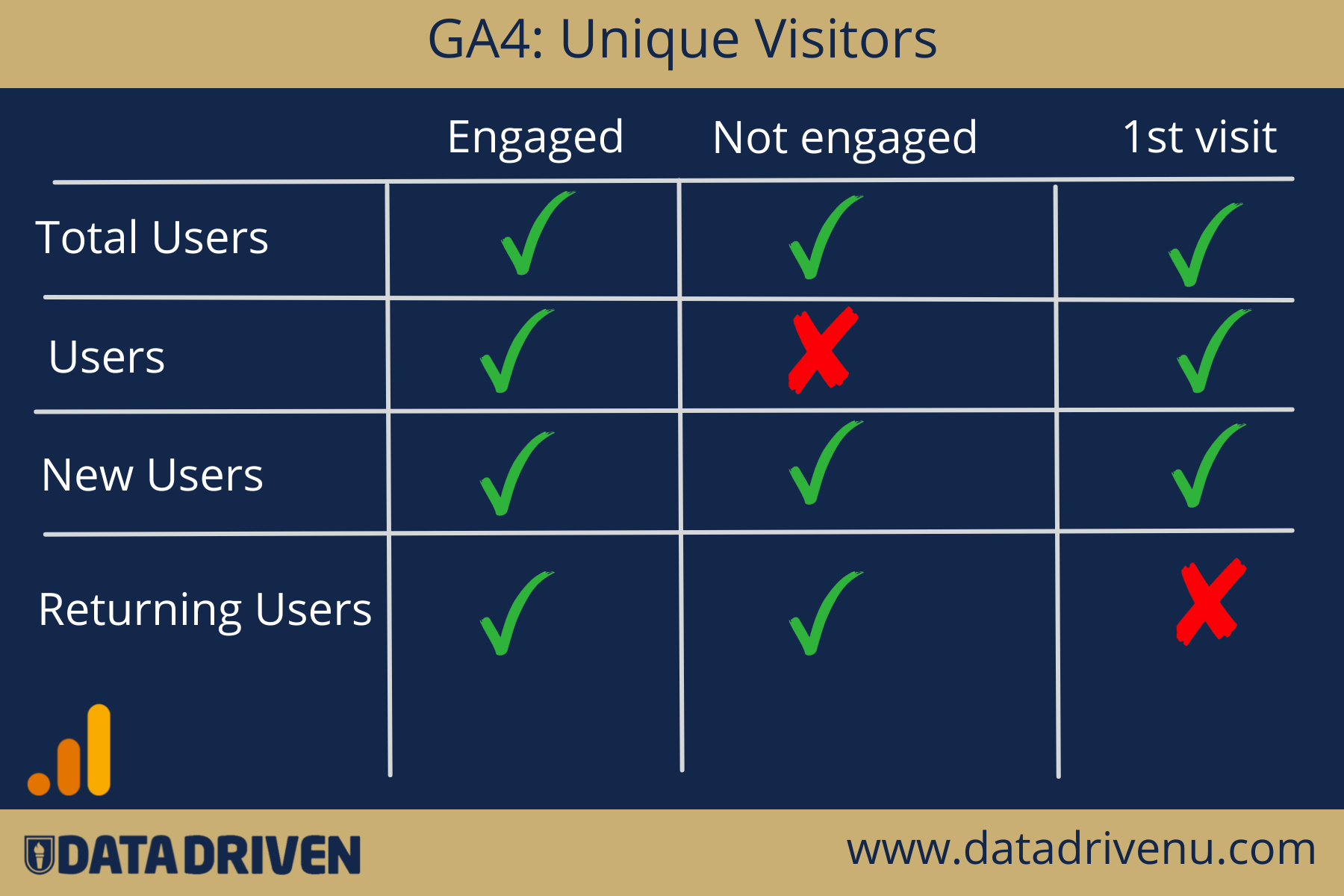
Distinguishing users this way can seem weird, but it actually makes a lot of sense.
Visits and visitors impact the happiness level of our cafe owner too.
- Damn: someone opening the door and leaving immediately.
- Nice: a visitor looks at the menu.
- Good: the visitor orders something from the menu.
- Awesome: the customer comes back.
The next time your boss or a colleague asks you how many unique visitors your site had, you know that the only right answer is: “It depends”.
For example, your site has
- 10,000 Total Users
- 2,000 (Active) Users
That. Is. Not. Good.
At all.
Those numbers actually mean that 8,000 of your returning visitors leave your site within 10 seconds or without doing anything at all.
Returning users because, as you know now, New Users are also added up to the Users metrics.
Let’s check (and hope) that this nightmare is not the case for you…
How to Find Unique Visitors in Google Analytics?
Changing the metrics in the home report of GA4 is the fastest way to see how many unique visitors your site had.
Just click on the arrow and choose metrics that answer your question the best.
In the screenshot below we used: “Total Users”, “New users”, “Returning Users” and “Sessions”.
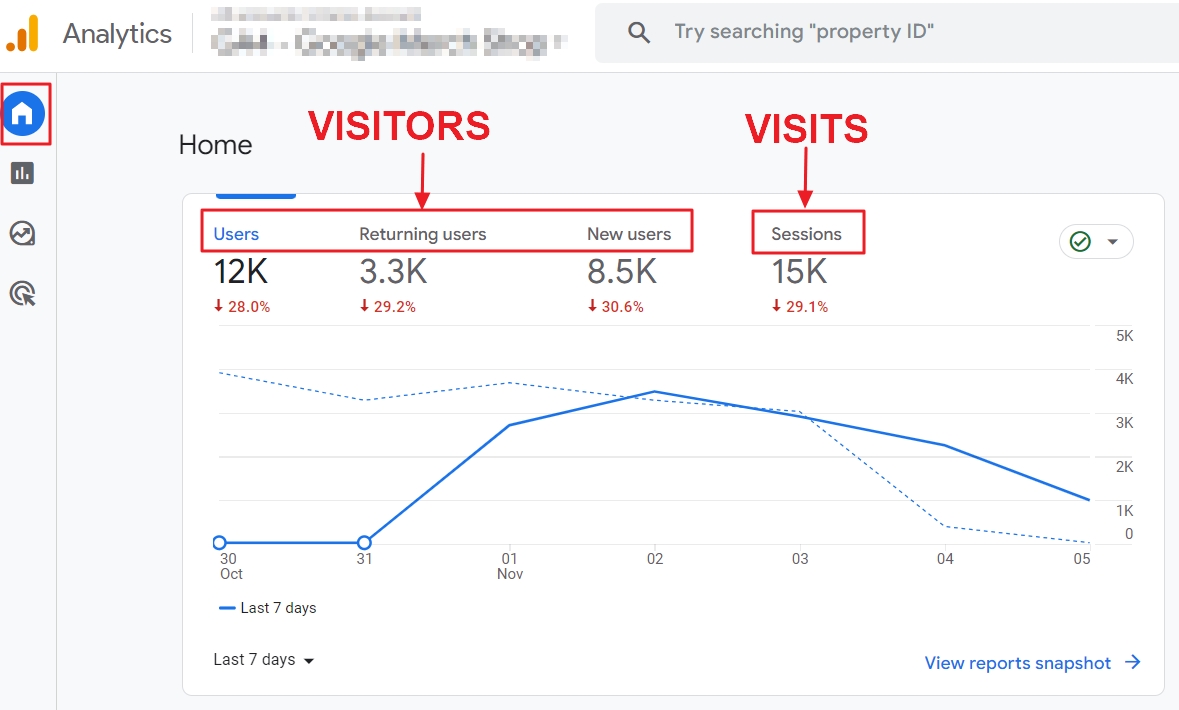
These metrics allow you to easily compare engaged visitors (Users) with new visitors (New Users) side by side.
But if you do the math, those numbers don’t seem to add up.
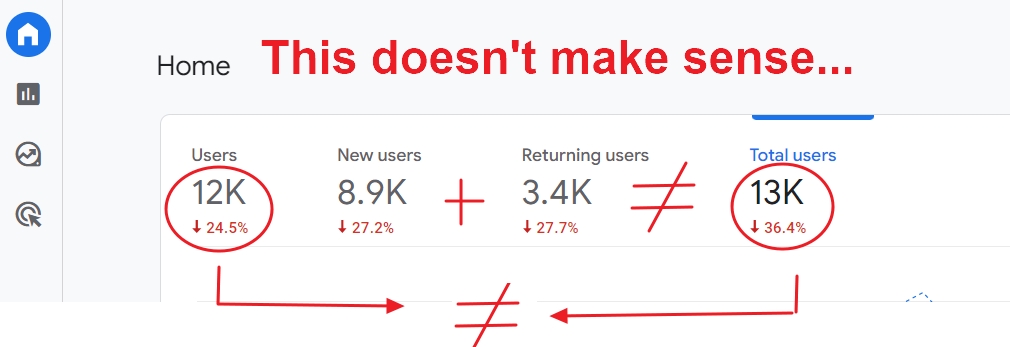
Why doesn’t the sum of Returning Users + New Users equals the Total Users in GA4?
The answer is actually simple.
Someone who visits a site for the first time and comes back later on, is both counted as a Returning User and a New User, but the Total User amount is only increased by one.
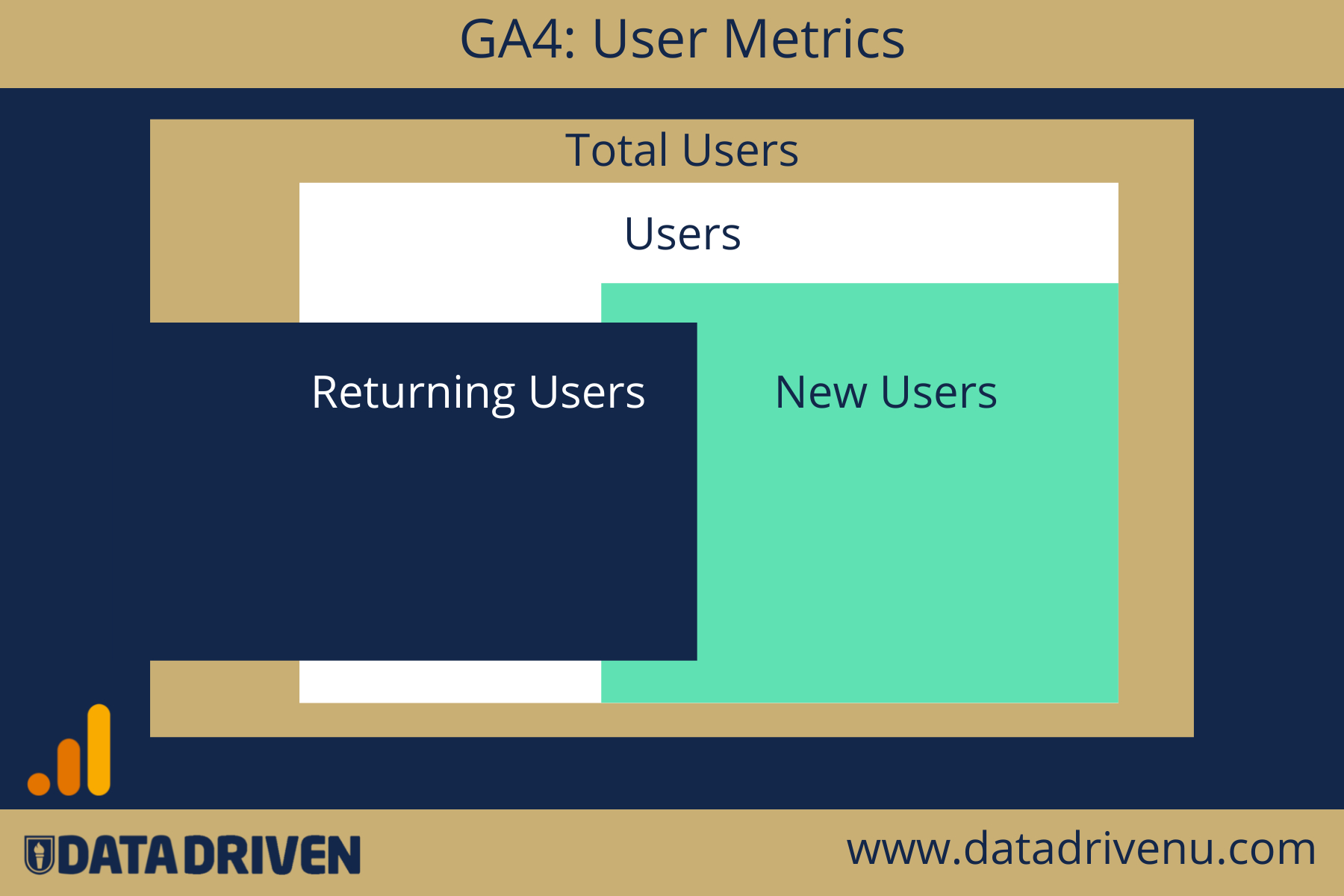
Let’s take it a step further and look at how you can easily detect in GA4 how many unique users there were in a certain period.
Unique visitors over time
Note that all metrics, including users and sessions, change when we change the time period. When you first log in to Google Analytics, the date range defaults to the most recent seven days, up till yesterday.
You can easily change the dates using the date drop-down box in the bottom left-hand corner.

In the above example, you can see that the number of unique visitors in the last seven days is 12k, while it shoots up to 66k when we increase the time period to the last 28 days.
The ability to view visitor data in different time frames allows you to have a more in-depth insight into user behavior – especially during events, marketing campaigns, holidays, and special days during the year.
If you wonder, for example, how Halloween impacts the amount of visitors and hence, visits to your site, you do the following.
- Go to the GA4 home report.
- Choose a period that includes the holiday.
- Choose user metrics as in the screenshot below.
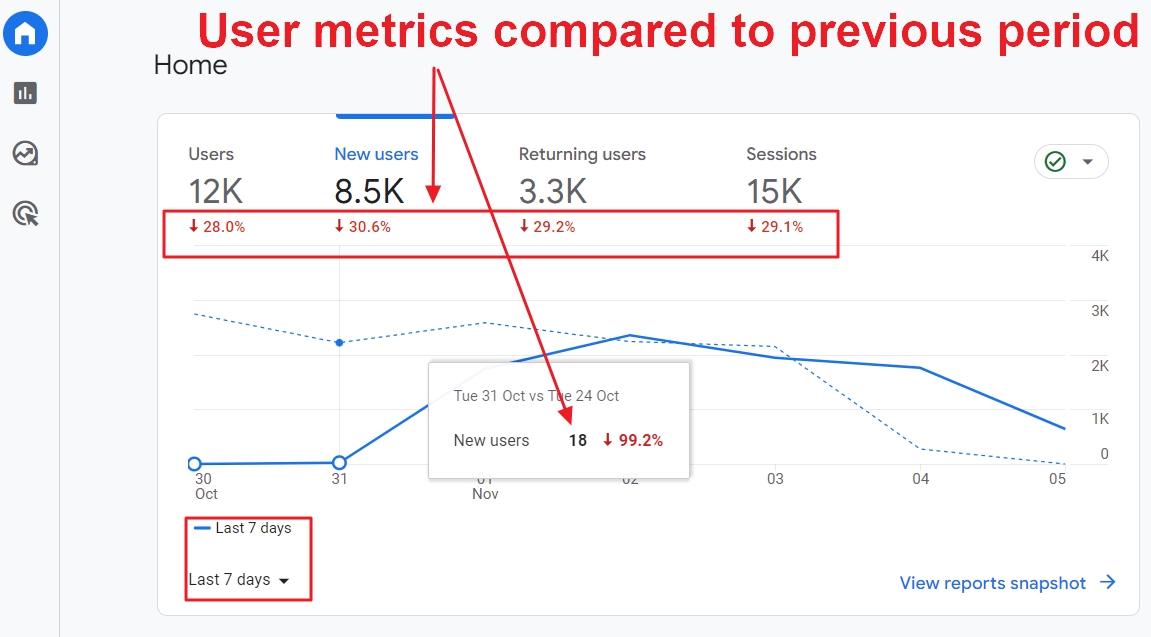
This simple graphs can give you instant insights about your site visitors over time:
- Compared to the previous 7 days, your unique New Visitors dropped 30.6%.
- Click on a user metric. The dotted line visualizes the curve for that metric during the previous period. The thick blue line represents the selected period.
- Click on the lines in the graph to see the details for a particular day. On the 31st of October, for instance, there was a 99.2% drop of new users, compared to the 24th of October.
This is the usual way to quickly analyze visitor data.
But did you know you can also ask questions in GA4 about your visitors?
Type anything you want to know in the search box on top of the page, like “How many users did we get last week on mobile?”

Cool, isn’t it? GA4 understands normal languages. And it gives instant answers.
Our free GA4 guide is filled with little hacks like these that will save you time. Make sure you grab your copy below.
Where are my visitors coming from?
It’s nice to know how many unique visitors you have, but it’s even more useful to know the nature of traffic.
In Google Analytics 4, you can analyze your first users by looking at the Acquisition > User acquisition report.

You can see metrics like New users, Engaged sessions, Engagement rate, Engaged sessions, etc. In the columns of the table, you can see where these first users were coming from.
You can change this default report and create a full custom report in GA4. That’s a clever way to analyze your users with metrics that truly matter to your business and your marketing campaigns. After all, traffic channels are not the only thing that are important.
The following technique is more advanced, but it also reveals more about anything you want to find out about your visitors.
Segmenting your visitors into audiences
The Audience section of Google Analytics allows you to analyze user data based on multiple parameters such as traffic source, demographics, operating system, browser, etc.

You can also analyze how website visitors engage with your web pages using metrics like sessions per user, pageviews per session, average session duration, and bounce rate.
GA4 can show you a lot about your visitors and their behavior on your site, but we haven’t asked one important question yet…
How Does Google Analytics Track Unique Visitors?
Google Analytics has 4 methods to identify unique visitors: User ID, Google Signals, Device ID, and Modeling.
Since we have covered some of these topics extensively on our blog, I link to the articles where you can find more information.
- User ID: This is something you can set up yourself with your developers. This is the most powerful method to identify users, but your site needs to have an account for users. They can be online shoppers, members of a community, or customers that use your app. We offer, for instance, a learning environment. Students all have a unique user ID and they can login to their account and access their courses about data marketing.
- Google Signals: visitors need to give consent and then Google can follow their online journey, including visits to your site across different devices.
- Modeling: this is the technique where Google AI fills in the gaps of, for instance, users that don’t allow cookies.
- Device ID: this is the oldest method, but it can also be used for apps.
All these 4 methods and combinations of them can be used to track unique visitors.
However, GA leaves the preferred user tracking method up to its users. That is you, or the administrator of your GA4 account.
Note that the GA4 user identification methods are not full proof.
When Google Analytics uses browser cookies to track unique visitors, there are certain situations where there is inaccuracy in user data. Returning users will likely be counted as new users if they:
- Browse the website in incognito mode
- Clear cookies on their browser
- Access the website through multiple devices
- Use different browsers on the same device
On the other side of things, many unique visitors might be counted as one user, for example, a family of three using one device or a group of students accessing a shared computer.

In summary: there are many reasons the data of your visitors in your GA4 reports is not 100% correct.
Google Analytics can’t track unique visitors perfectly, but data is better than no data
Which method does GA4 use in my account to identify users?
As a marketer or data analyst, you need to be aware of one thing. The amount of unique users in your GA reports depends on the tracking method that is activated in your GA4 account. There are three options: blended, observed and device-based.
This is how you can see which method GA4 is using to track and identify visitors:
- Go to the admin section of your GA4 account.
- Then open the reporting identity section.
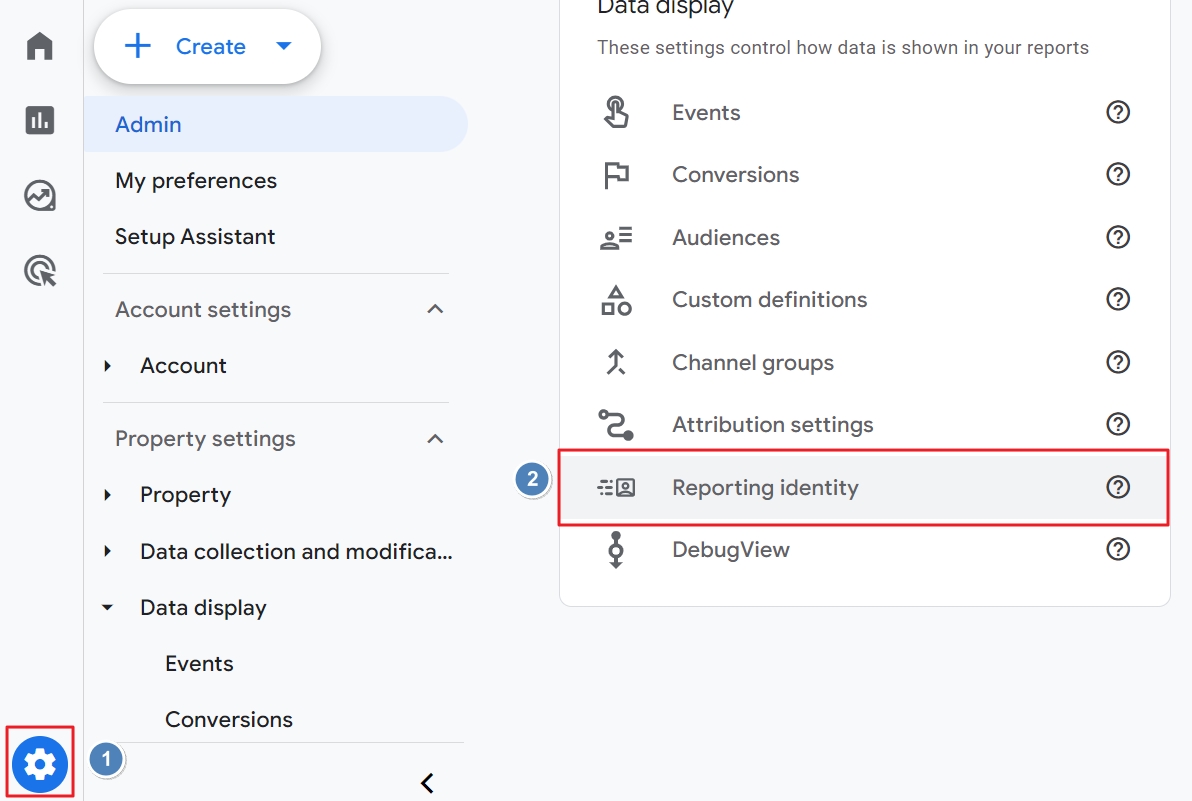
Note that the active reporting identity can have inactive tracking methods.
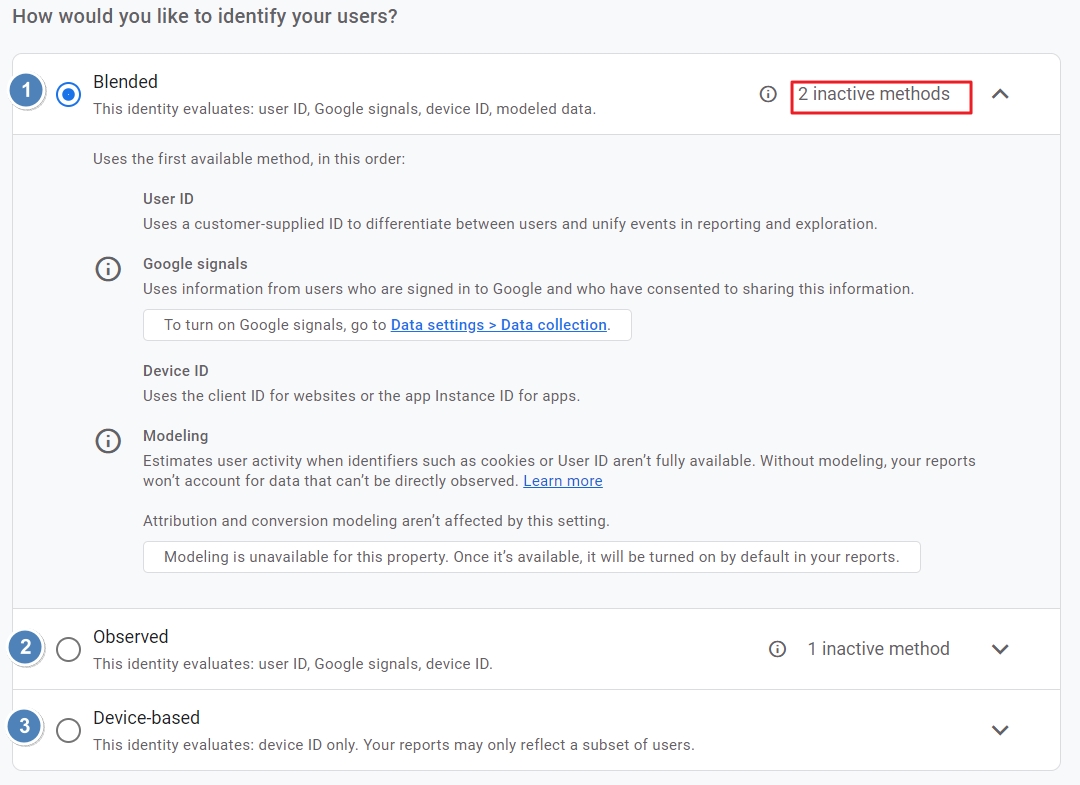
Even if your user role doesn’t have permissions to change anything here, it is still worth having a look. Especially when you are doing a GA4 audit for a customer or your own site.
But, don’t change the user tracking method, unless
- you know what you are doing
- you have properly informed your team
- you have good reasons to change it. Privacy and user consent are damn good reasons.
To illustrate why this is risky, let me share a screenshot of the video on top of this article.
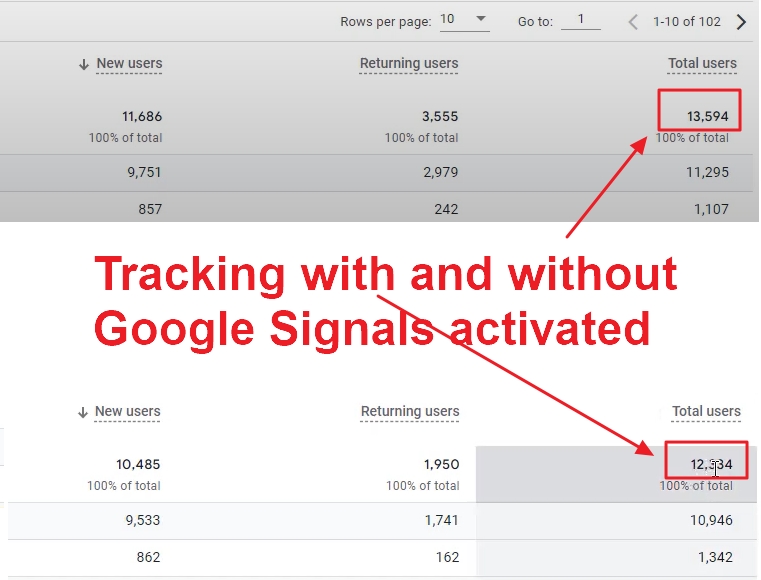
- Google Signals activated: 12,334 unique visitors
- Without Google Signals: 13,594 unique visitors
That’s a scary difference in my opinion.
Difference Between Users and New Users
Remember when Ben, Eva, Matt, and Cindy went to the cafe for lunch? It turns out that they were so delighted by the food that they brought two more friends, Mike and Jo, with them the next day for a special Sunday brunch.
Since unique visitors are counted for a specific date range, the number of unique visitors to the cafe on Sunday is six, while there are two new visitors.
Similarly, new users in Google Analytics are people who have visited your website for the first time, irrespective of the date range.
Note that new users are a subset of unique visitors or users.
The New Users data is instrumental when running a marketing campaign – like an influencer marketing campaign or social media advertising – to measure and compare new user acquisition effectiveness.
The returning users metric is especially handy when your marketing efforts are centered around your content and you have sizable newsletter subscribers or social media followers.
What Do Pageviews and Unique Pageviews Mean in Google Analytics?
When Ben, Eva, Matt, and Cindy visited the cafe, each of them ordered a hamburger and soda. Ben and Cindy also had a dessert each, while Matt opted for another soda instead of a dessert. Here, the different items ordered in the cafe correspond to users viewing different web pages on your website.
In Google Analytics, pageviews means the total number of individual pages or posts viewed on your site. If the items ordered in the restaurant were pageviews, the total count would be 11 (4 hamburgers, 4 sodas, 2 desserts, and 1 more soda).
To view pageviews and unique pageviews for your individual webpages, you can visit the pages and screens report.
Take a look at your “Engagement > Pages and Screens” report. Top performing pages are shown with the page title and performance metrics. This report also shows how many Users viewed each page.
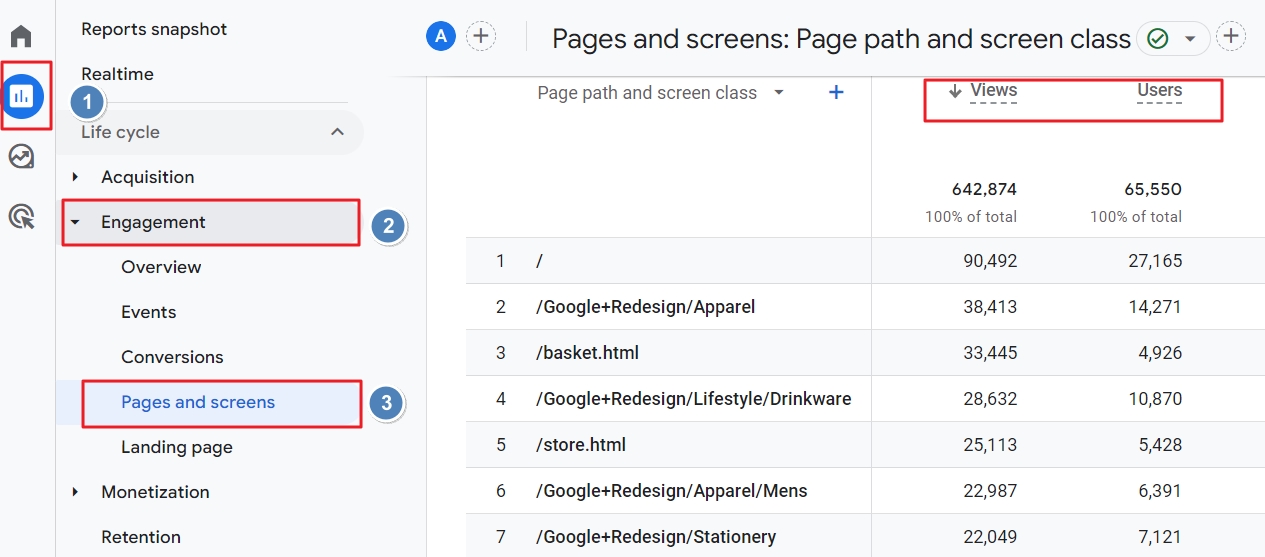
Unique pageviews only denote the number of unique pages visited by a user in one session. Unique pageviews weed out refreshes and revisits and paints a clearer picture of the web traffic and your content engagement.
In general, new users engage more with your webpages because the content is, essentially, still new for them. On the other hand, returning users have already visited your website at least once and probably read your previous posts.
Hence, their average pageviews per session is usually lower than returning users.
Google Analytics expert Eddie Lee explains that in Google Analytics 4 as follows:
“Things are a little different. Everything is an event- including page views. By default, page view, scrolls, clicks, site search, video engagement and file downloads are tracked automatically on a default installation.”
Why Should You Care About Unique Visitors?
With all that in mind, what’s the actual use case for unique visitors?
Let’s say you have a website that sells a product and you also have a large email list that you regularly sell to.
When looking at your conversion rate, you notice that your overall conversion rate for January is 8%
Not bad!
But when you look at your conversion rate for unique visitors you notice that it’s only 0.5%.
Ouch. What’s going on here?
While you should expect to have a higher conversion rate from people who are already engaged with your brand (the majority of which may be coming from your email list), depending on your product the conversion rate for unique visitors may be too low.
By segmenting out unique visitors, you can see how people who are brand new to your site interact with your brand and have a better understanding of how to grow that side of the business. Instead of just seeing your awesome overall conversion rate and moving on.
So, what’s next?
Whether you are a new or returning visitor to our site, you are a unique person with unique marketing and data skills, questions and needs.
That makes it impossible for me to give you solid advice on what to do next. But here are some suggestions.
Grab your free copy of GA tips and advice. Even if you are an expert, this will save you time in GA4.
Would you like to dive deeper into user data in GA?
Or maybe find a topic to discuss next time you visit a cafe?
These articles will not disappoint you.
Starter level: Understand sessions in GA4.
Intermediate level: Dive into the user journey with the path exploration report.
Expert level: Get even more insights about your visitors by tracking user properties.

